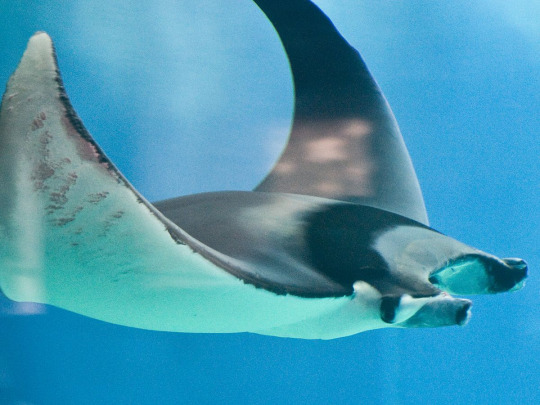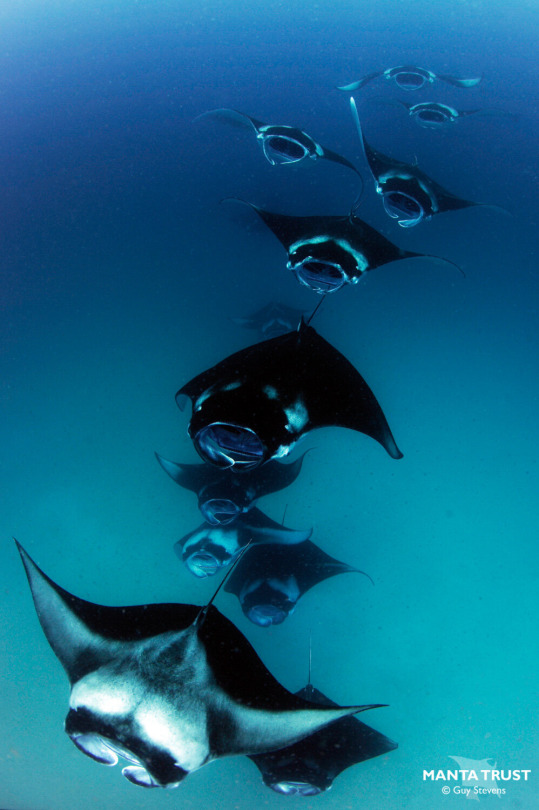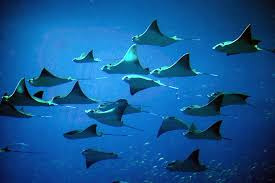#mobulidae
Explore tagged Tumblr posts
Text

Golden Trevally (Gnathanodon speciosus), juveniles, family Carangidae, order Carangiformes, school near the front of a Manta Ray (Mobula sp.), family Mobulidae, order Myliobatiformes in the South Pacific
photograph by Jake Wilton (@jakewiltonphoto)
#manta#ray#mobula#mobulidae#elasmobranch#myliobatiformes#fish#ichthyology#bony fish#jack#trevally#gnathodon#carangidae#carangiformes#animals#nature#ocean
503 notes
·
View notes
Text
Today is Monday so that means it’s time….
TIME TO PICK THIS WEEKS SEA CREATURE OF THE WEEK!!!!
The sea creature of the week isssss
‼️‼️ THE DEVIL FISH‼️‼️
devil fish or giant devil ray are a species in the mobulidae family, they are 3.5 meters long and feed on plankton and small schooling fish, it’s main predators are sharks and killer whales, but it’s death is sadly usually by humans


2 notes
·
View notes
Text





44 notes
·
View notes
Text
Animal of the Day!
Giant Devil Ray (Mobula mobular)

(Photo by Patrik Neckman)
Conservation Status- Endangered
Habitat- Indo-Pacific Ocean; Eastern Atlantic Ocean; Mediterranean Sea
Size (Weight/Length)- 3.5 m width
Diet- Krill; Plankton; Small fish
Cool Facts- The giant devil ray is the third largest mobula species. These are the only mobulidae found in the Mediterranean Sea. The rays live in small groups and only have offspring once every few years. Capable of gaining a high amount of speed, giant devil rays can breach multiple meters from the water. The reason why they breach from the water is unknown but it could be done for communication or just for fun. Due to their slow growth mixing with pollution and bycatch, the giant devil ray population has declined greatly in the last few decades. These rays are highly sensitive to any change in their environment and are heavily impacted by longlines, trawl nets, and tuna traps. Luckily, multiple European countries such as Italy and Croatia are working together to protect this magnificent species.
Rating- 13/10 (No longer called a manta.)
#animal of the day#animals#ray#marine creature#mobula#saturday#july 29#giant devil ray#biology#science#conservation#the more you know
179 notes
·
View notes
Text
Giant Oceanic Manta Ray



Name: Giant Oceanic Manta Ray
Scientific Name: Mobula birostris
Family: Mobulidae
Location: "...found worldwide in tropical, subtropical, and temperate bodies of water..."
Status:
Fun Facts: Threatened
• These rays occasionally do 'barrel rolls' to hunt, similar to gators.
• They have the largest brains of any fish as far as we've researched.
• They are the largest type of ray in the world.

Sources: 🌊 / 🌊 / 🌊
#sea creature of the week#marine life#sea creatures#marine biology#ocean#ocean creatures#ocean life#sea critters#sea life#info blog#giant oceanic manta ray#manta ray#ray#giant manta ray
9 notes
·
View notes
Text
Fish of the Week #3: The Reef Manta Ray

The reef manta ray (Mobula alfredi) is a member of the Mobulidae family, also known as Mobulid Rays.
It is the second-largest species of ray, behind only its counterpart, the giant oceanic manta ray. They tend to be 10-11.5 feet (3-3.5 meters), but can grow up to 16 feet (5 meters).
It can be found widely in the tropical and subtropical Indo-Pacific, in the waters around southeastern Asia and Australia.
It is listed as vulnerable on the IUCN. While there are few natural predators of the manta ray, overfishing has put their numbers in a steady decline over the last several years. The demand has increased because of a pseudo-medicinal attribute assigned to their gill rakers (without any significant evidence).
Fun facts:
The reef manta ray was only confirmed as a separate species from the giant oceanic manta ray (Mobula birostris) in 2009.
Manta rays have been one of the only non-human species to pass the mirror test, considered a prerequisite for sapient status in animals and something that even dogs have failed.
The protrusions on the sides of the manta ray’s face are called cephalic lobes or horns.
———
Here are some ways you can distinguish between the oceanic and reef manta ray!
1. Size.
- Where reef mantas tend to be 10-11.5 feet, oceanic mantas are usually 13-16 feet (4-5 m). This will only work for mature rays, however.
2. Colors and patterns.
- The reef manta ray will have two lighter colored markings on the sides of its head, fading as the color goes down its back, with the darker color above and around it forming nearly a Y shape. In contrast, the oceanic manta’s colors will not fade slowly and the darker color around it will form more of a T shape.
- While the oceanic manta will have dark markings on the inner sides of their cephalic lobes, the reef manta will not. In addition, the reef manta will have spots more spread out on its underside, but the oceanic manta will only have them on its lower abdomen and the spots will be closer together.
———
I love manta rays.
#fishblr#fish#fotw#fish of the week#fotw 3#fish of the week three#manta ray#manta ray fish#reef manta ray#reef manta ray fish#fishy friday
6 notes
·
View notes
Text
Manta Rays

Manta rays are magnificent creatures that roam the ocean with elegance. These gentle giants belong to the family Mobulidae and are closely related to sharks. In this blog post, I will explore the fascinating world of manta rays, including their characteristics, behavior, and conservation status.
Manta rays are known for their distinctive appearance and impressive size. Here are some characteristics of these magnificent animals:
Size and Shape:

Coloration:

Fins:
Manta rays possess two large, triangular pectoral fins on either side of their body, which they use to “fly” through the water. These fins are one of their more distinctive features.

Manta rays are filter feeders, using a specialized structure called cephalic lobes to direct water into their mouths while they swim. They primarily feed on plankton, small fish, and crustaceans.
Behavior and Habitat:
Manta rays are predominantly found in tropical and subtropical waters across the globe. Here are some notable aspects of their behavior and habitat.

Manta rays are known to undertake long-distance migrations, traveling between different feeding and breeding grounds. These migrations can cover hundreds or even thousands of miles.
Social Behavior:
Manta rays are generally solitary creatures, but they occasionally form groups when feeding or during mating season. These groups can grow to dozens.
Species and Distribution:
There are two recognized species of manta rays: the reef Manta Ray(Manta alfredi) and the giant manta ray(Manta birostris). The reef manta ray is found in warmer coastal waters like coral reefs and lagoons, while the Giant Manta Ray inhabits both coastal and open oceans.
Lifespan:
Manta rays have a relatively long lifespan compared to other fish species. They can live up to 40 years old and more, depending on various factors such as environmental conditions and predation risks.
Manta rays exhibit intriguing behaviors that add to their allure. They are known for their acrobatic leaps out of the water, which is called breaching. This act is believed to serve various purposes like communication, courtship displays, and parasite removal.

Cultural Significance:
The manta ray holds cultural significance in several regions they are found in. They are celebrated in local folklore, art, and traditional ceremonies. (Manta rays have rich mythological significance in various cultures. In Hawaiian mythology, the manta ray is known as "Hōlua" and is considered a guardian spirit. It is believed to possess great wisdom and is seen as a protector of the ocean and its creatures. In some African cultures, manta rays are associated with ancestral spirits and are believed to be messengers between the human and spirit worlds. They are revered as wise and powerful beings, embodying the connection between the physical and spiritual realms.)
Conservation Status and Importance:
Manta rays face numerous threats including overfishing, bycatch, habitat degradation, and pollution. These factors have led to a decline in the manta ray population worldwide. Recognizing their ecological significance, efforts are being made to protect and conserve these magnificent creatures. Some key conservation initiatives include:
International Protection:
Manta rays are protected by international organizations and conventions, such as CITES (Convention on International Trade in Endangered Species) and the CMS. (Convention of Migratory Species.)
Marine Protected Areas (MPAs):
Establishing MPAs and protected marine reserves serve as breeding grounds, and essential feeding areas and help safeguard their habitat. (Not just manta rays but for other marine species too)
Manta rays are truly remarkable creatures that continue to fascinate researchers, scientists, and me:) By appreciating their beauty, studying their behavior and actively working to preserve their species, we can ensure a brighter future for these gentle giants. And with that, this blogger bids you goodbye,Stay With Wonder!
3 notes
·
View notes
Note
This is actually perfect for a character question I've been thinking of
Do sharks have sexual dymorphism? I am headcanoning Yona from ToTK as a trans woman and I wanna poke at her design to add to this headcanon
oh this is a great question! and also a perfect opportunity to teach folks about sexual dimorphism.
for those who don't know, sexual dimorphism is the phenomena that the different animals in nature where there are physical differences between the male and female that is not reproductive organs. a common one you may see is either the male or female is larger. this does not apply to all species however!!! sometimes it's the fact one species is more vibrant and colorful compared to the other. (think of peacocks). sometimes it's both. (think of the black widow spider)
for sharks and rays (i am going off of the assumption that yona is a part of the mobulidae family or something adjacent to it considering the fact she's a zora and not um. an actual ray.) i would say yes!!! it depends on the species like i've said. sometimes it's reliant on the fins, or sometimes it's more morphological. as stated by this paper, "Males and females of the same species may respond differently to selective pressures. In the case of elasmobranchs, the differences between males and females include variations in their external reproductive anatomy, body size, dental formula, number and distribution of Ampullae of Lorenzini, and dermal thickness." (If you have the time to or feel intrigued enough, do read it! it has some interesting information regarding this exact subject with sharks)
however, this isn't about sharks, this is about rays! the shape of yona's head is structurally similar to that of a ray. well what do people think about that?
going off of the idea that yona is a ray, what kind is she? she seems to lack the lobes protruding from the front like muzu does, but her design Does have horns. so, i guess it counts? let's take a wild guess and say that yona is some kind of giant manta ray. female giant manta rays have been recorded to have a wingspan of 18.3 to 22.7 ft. on the other hand, male giant manta rays have been recorded to have a wingspan between 17.3 to 20.3 ft. big, but not as big as the females.
conclusion? i am not sure to be honest. if the conclusion is that yona is accidentally trans coded? go ahead! if it's not, you can still headcanon her as trans! nobody can stop you.
5 notes
·
View notes
Text

[ID: a worksheet. "mobu" in "family mobulidae" is circled, with a red line connecting it to mob from mob psycho 100. end ID.]
4 notes
·
View notes
Video
tumblr
LAST SATURDAY.......The giant oceanic manta ray is a species of ray in the family Mobulidae, and the largest type of ray in the world. It is circumglobal and is typically found in tropical and subtropical watersDive with us! Work later COSTA RICA PURA VIDA https://www.tamarindodiving.net/diving-tourshttps://www.tamarindodiving.net/courses +506.8583.5873. WhatsApp [email protected]
1 note
·
View note
Text
layla glances back up the water surrounding them. she catches the sight of a massive manta ray gracefully moving through the water as if it was flying. "i don't really have much intention of actually going in the ocean to the depths these guys are at." she points up to the mobulidae in question less than a metre above her head, "i get to see them, stay dry — and most importantly alive — here."

Major could relate to her shock at having lived in Aurora Bay for years but never visiting the Aquarium before. He'd spent countless summers here with his family growing up and there was still corners of town that he had never visited. "I guess it feels pretty redundant visiting an aquarium when you could run down to the beach and find most of the fishes and other aquatic life for free."

46 notes
·
View notes
Photo

Photo by Black Box | Info
The Munk's devil ray, pygmy devil ray, or smoothtail mobula (Mobula munkiana) is a species of ray in the family Mobulidae. It is found in tropical parts of the eastern Pacific Ocean. These rays can be alone, in small groups or in schools, near the surface of the sea or near the seabed. They have been documented to leap out of the water, either alone or in groups, performing vertical jumps, somersaults and other acrobatic maneuvers.
#munk's devil ray#pygmy devil ray#smoothtail mobula#mobulidae#mobula munkiana#ray#rays#marine biology#marine photography#underwater photography
984 notes
·
View notes
Photo

What's the coolest form of wildlife you've interacted with? #mantaray #mobulidae #freedive #hawaiidiving #mantadive #seethroughsea #underwateradventures #mantaconservation #blueplanet2 #aumakua #808 #lifestylechoices (at Kailua-Kona, Hawaii) https://www.instagram.com/p/B2V8OgAnMHn/?igshid=1xb1a3fvzbk0p
#mantaray#mobulidae#freedive#hawaiidiving#mantadive#seethroughsea#underwateradventures#mantaconservation#blueplanet2#aumakua#808#lifestylechoices
12 notes
·
View notes
Photo

NEW MERCH: Link to redbubble store is in our bio! This is our long-awaited manta design! The original sketch was made by Olivia McElreath, and the digital linework and coloring was done by the Typus Data founder! All four Georgia Aquarium mantas are shown here, from top going clockwise: Tallulah, Billi, Nandi, and Raven. This design is available on a variety of products - shirts, tablet cases, notebooks, and - of course - stickers! •••••••••••••••••••••••••••••• #mantaray #mantarays #manta #mantas #georgiaaquarium #mobula #mobulidae #ray #rays #batoidae #art #elasmoart #elasmobranch #elasmobranchs https://www.instagram.com/p/B1B-7hiBaLr/?igshid=1gpe36aebdd1n
#mantaray#mantarays#manta#mantas#georgiaaquarium#mobula#mobulidae#ray#rays#batoidae#art#elasmoart#elasmobranch#elasmobranchs
1 note
·
View note
Photo

New Manta ray pendant! - Polymer Clay, Swellegant and copper wire 🤗 Perfect for a summer on the beach 🏝 - #mantaray #mobulidae #stingray #manta #rayfish #copper #bronze #patina #swellegant #polymerclay #polymerart #polymerclaypendant #polymerclayartist #leilabidler #sculpey #premoclay https://www.instagram.com/p/CRbFQ6TjjXR/?utm_medium=tumblr
#mantaray#mobulidae#stingray#manta#rayfish#copper#bronze#patina#swellegant#polymerclay#polymerart#polymerclaypendant#polymerclayartist#leilabidler#sculpey#premoclay
0 notes
Link
It's a shiny!


Just in time for the rosiest holiday of the year, another diver has snapped a rare photo of Inspector Clouseau, the world’s only known pink manta ray.
First spotted lurking in the waters off Australia’s Lady Elliot Island in late 2015, the 11-foot male fish—cheekily named for the detective in the Pink Panther franchise—has been glimpsed only a handful of times since, reports Bethany Augliere for National Geographic. So rare are the sightings that Kristian Laine, the photographer behind Clouseau’s most recent close-up, was certain the ray’s coloration was an artifact of malfunctioning camera equipment.
Clouseau was concealed by seven other male manta rays, all flashing more typical white undersides. According to Australian Geographic, the fishy octet had assembled to vie for the attention of a nearby female—an elaborate courtship ritual that typically involves a lady ray releasing pheromones into the water before zooming away, triggering a train of males into giving chase.
#inspector clouseau#manta#manta ray#mobulidae#myliobatiformes#batoidea#ray#chondrichthyes#cartilaginous fish#fish#pink#mutation#erythrism
20K notes
·
View notes